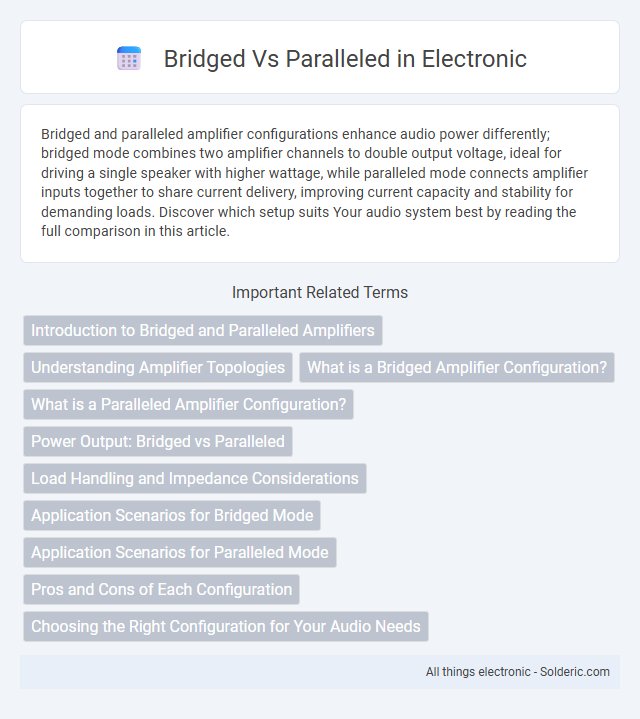Bridged and paralleled amplifier configurations enhance audio power differently; bridged mode combines two amplifier channels to double output voltage, ideal for driving a single speaker with higher wattage, while paralleled mode connects amplifier inputs together to share current delivery, improving current capacity and stability for demanding loads. Discover which setup suits Your audio system best by reading the full comparison in this article.
Comparison Table
| Feature | Bridged | Paralleled |
|---|---|---|
| Definition | Combining two amplifier channels into a single channel with increased output power. | Connecting amplifier channels side-by-side to double current or wattage capacity while maintaining the same voltage. |
| Output Power | Increases voltage, typically doubling output power. | Increases current capacity, improving power handling. |
| Impedance Load | Requires minimum speaker impedance (usually double) to prevent amplifier damage. | Speaker impedance is halved as channels share the load. |
| Usage Scenario | Ideal for driving a single speaker with higher power demand. | Suitable for driving multiple speakers or improving amplifier reliability. |
| Risk | Risk of amplifier damage if speaker impedance too low. | Less risk, but careful matching of impedance is necessary. |
| Complexity | Moderate wiring complexity. | Higher wiring complexity due to parallel connections. |
Introduction to Bridged and Paralleled Amplifiers
Bridged and paralleled amplifiers differ in configuration and power output capabilities. Bridged amplifiers combine two channels to double the voltage output, effectively quadrupling power delivered to a single load. Paralleled amplifiers connect multiple amplifier outputs to share the current load, increasing output current capacity and improving reliability for driving low-impedance speakers.
Understanding Amplifier Topologies
Bridged and paralleled amplifier topologies enhance audio power output by using multiple amplifier channels to drive a single load. Bridging an amplifier combines two channels to effectively double the voltage output, resulting in four times the power delivered to the speaker, ideal for high-impedance loads. Paralleled amplifiers share the current load by connecting channels in parallel, improving current capacity and reducing distortion, which benefits low-impedance speakers and subwoofers.
What is a Bridged Amplifier Configuration?
A bridged amplifier configuration involves connecting two amplifier channels to drive a single load with double the voltage swing, effectively increasing the output power without requiring a higher supply voltage. Each amplifier channel produces an equal but opposite voltage signal, creating a differential output that doubles the voltage across the load. This configuration is commonly used in audio systems to maximize power output while minimizing the need for more complex amplifier designs or higher supply voltages.
What is a Paralleled Amplifier Configuration?
A paralleled amplifier configuration connects multiple amplifier channels in such a way that their outputs combine to increase the total current capacity, resulting in higher power output without altering the voltage gain. This setup is ideal for driving low-impedance loads, such as subwoofers, by reducing strain on individual amplifiers and ensuring better heat dissipation. Paralleled amplifiers maintain the original voltage signal while multiplying current, making them effective for high-power audio applications.
Power Output: Bridged vs Paralleled
Bridged and paralleled amplifier configurations differ significantly in power output capabilities; bridged amps combine output voltages to increase power to a single speaker, effectively doubling the voltage swing and resulting in up to four times the power compared to a single amplifier channel. Paralleled amps share the load across multiple amplifier channels, maintaining the same voltage but increasing current capacity to deliver higher overall current to the speaker, which enhances power output without increasing voltage. Understanding these differences helps you select the right configuration to maximize your audio system's power and efficiency based on your specific speaker setup.
Load Handling and Impedance Considerations
Bridged amplifier configurations typically double the voltage output, resulting in higher power delivery to a load but effectively halving the load impedance seen by each amplifier channel, which can challenge amplifier stability if the impedance is too low. Paralleled amplifiers share the current load, reducing the overall output impedance and allowing better handling of low-impedance speakers without overstressing individual amplifier channels. Your choice between bridged and paralleled setups depends on matching the amplifier's specifications to the speaker's impedance to ensure optimal load handling and system efficiency.
Application Scenarios for Bridged Mode
Bridged mode is ideal for applications requiring increased power output to drive a single high-impedance load, such as powering large subwoofers in car audio or home theater systems. This configuration effectively combines two amplifier channels into one, doubling the voltage output for enhanced audio performance. It is well-suited for scenarios where maximizing power delivery from existing amplifier channels is critical without adding extra amplifier units.
Application Scenarios for Paralleled Mode
Paralleled mode is ideal for applications requiring increased power output without changing the load impedance, such as in subwoofer systems or multi-driver speaker setups. This configuration allows multiple amplifier channels to share the load, enhancing current delivery and improving thermal management. Paralleled mode is frequently utilized in professional audio systems and car amplifiers where robust, high-current performance is essential.
Pros and Cons of Each Configuration
Bridged amplifier configurations combine two channels into one, offering increased power output and driving a single speaker with higher voltage, but they often produce more distortion and heat, requiring robust cooling systems. Paralleled amplifiers split the load across multiple channels, reducing distortion and improving reliability by sharing the current, yet they provide less power per channel compared to bridged setups and may increase system complexity. Choosing between bridged and paralleled depends on whether maximum power output or improved signal clarity and system durability are prioritized.
Choosing the Right Configuration for Your Audio Needs
Bridged and paralleled amplifier configurations each offer distinct advantages depending on your audio setup requirements. Bridged mode doubles the voltage output for a single channel, delivering higher power ideal for driving subwoofers with demanding bass. In contrast, paralleled mode allows you to combine multiple amplifier channels to increase current capacity, providing improved reliability and performance for multi-speaker systems tailored to your specific sound environment.
Bridged vs Paralleled Infographic

 solderic.com
solderic.com